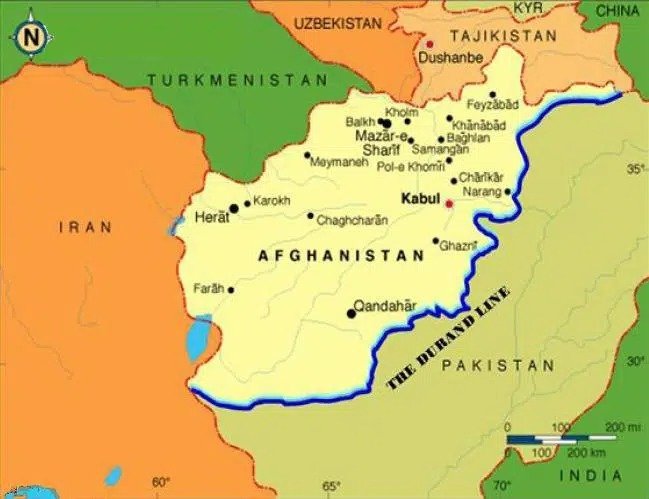Laiba Mahmood
America’s hasty withdrawal from Afghanistan in 2021 triggered a cascade of chaos. The Taliban’s rapid takeover of Kabul not only underscored the fragility of the Afghan state but also reignited old fears in Pakistan. As Afghanistan grapples with its internal crises, Pakistan finds itself at a critical juncture, where its stability and security are intrinsically linked to the fate of its war-torn neighbor. This enduring relationship demands an honest reckoning of past policies and a bold rethinking of Pakistan’s role in the region.
While Afghanistan and Pakistan officially recognized each other in 1948, their relationship has been fraught with mistrust from the very beginning. The Durand Line, a colonial-era boundary drawn in 1893, remains a source of contention. Over the years, Afghanistan’s refusal to accept the border as permanent fueled tensions, compounded by ethnic and cultural complexities. The Soviet invasion of Afghanistan in 1979 and the subsequent Afghan Jihad, supported by Pakistan and funded by the United States, brought about seismic shifts. Pakistan’s role as a frontline state was hailed as a geopolitical success at the time, but it unleashed a torrent of long-term consequences. Over 3 million Afghan refugees entered Pakistan, straining its resources and altering its social fabric. The proliferation of arms and extremist ideologies during this era sowed seeds of instability that continue to haunt Pakistan today.
The 9/11 attacks in 2001 thrust Pakistan into a new phase of entanglement with Afghanistan. As America’s “frontline ally” in the War on Terror, Pakistan bore the brunt of militant blowback. While the world focused on dismantling al-Qaeda and the Taliban, Pakistan became a battleground for terrorism. The statistics are grim: over 80,000 casualties, including civilians and security personnel, and economic losses exceeding $150 billion. Entire regions in Pakistan’s northwest turned into war zones, displacing communities and devastating livelihoods. The relentless wave of terror attacks exposed the fragility of Pakistan’s internal security apparatus and the far-reaching implications of its alliance with the U.S.
The porous 2,640-kilometer-long Durand Line binds Pakistan’s security to Afghanistan’s fate. Militancy and refugee flows underscore the impossibility of remaining neutral. Since the Cold War, this situation has strained Pakistan’s resources, contributing to housing shortages, pressure on public services, and unemployment. The informal economy absorbed many refugees, but their presence also facilitated the growth of smuggling networks, including narcotics, weapons, and other contraband. This illegal trade not only undermined Pakistan’s economy but also fueled corruption and crime, further destabilizing the region.
Whether it likes it or not, Pakistan is deeply enmeshed in Afghanistan’s affairs, and this interdependence demands proactive engagement, not reactive crisis management. Yet, Pakistan’s policy approach often appears mired in contradictions. Historically accused of harboring a dual policy towards Afghanistan—supporting the Taliban while aligning with the West, Pakistan faces an uphill battle in reshaping its narrative. Although it seeks to support regional stability, it struggles to balance relations with the Taliban-led government and address international concerns about human rights.
Pakistan’s policy dilemma highlights the challenges of navigating a volatile neighborhood. The asymmetric nature of threats emanating from Afghanistan—from cross-border terrorism to the influx of refugees—requires a mix of soft and hard power strategies. Pakistan’s leadership must adopt a nuanced approach, leveraging diplomatic channels to foster regional stability while strengthening its internal security apparatus. The Durand Line not only facilitates illicit activities but also undermines Pakistan’s ability to project strength in the region. Enhanced border controls, coupled with investments in infrastructure and surveillance, can mitigate these risks. Moreover, fostering economic ties with Afghanistan could serve as a stabilizing force, providing both countries with incentives to maintain peace.
We must reassess our Afghanistan policy through the lens of our own national interest. Pakistan’s ambitious plans for economic integration, such as the China Pakistan Economic Corridor (CPEC), hinge on a stable Afghanistan that can act as a conduit for trade with Central Asia. The current instability hampers these prospects, limiting Pakistan’s economic growth and its role as a regional trade hub. The international community, too, has a role to play. Sustainable solutions to the Afghan refugee crisis, including greater financial and logistical support from global powers, are essential.
The Afghan quagmire is not merely a geopolitical issue; it is a test of Pakistan’s resilience and vision. By taking bold, forward-looking steps, Pakistan can transform its role from a victim of Afghanistan’s instability to a key player in fostering regional peace and prosperity. The question is whether Pakistan’s leadership can muster the political will to rise to the occasion. If Pakistan fails to act decisively, it risks perpetuating a cycle of instability that undermines its own security and economic aspirations. Conversely, a proactive, strategically sound approach could position Pakistan as a stabilizing force in South Asia, turning challenges into opportunities for growth and regional leadership.










